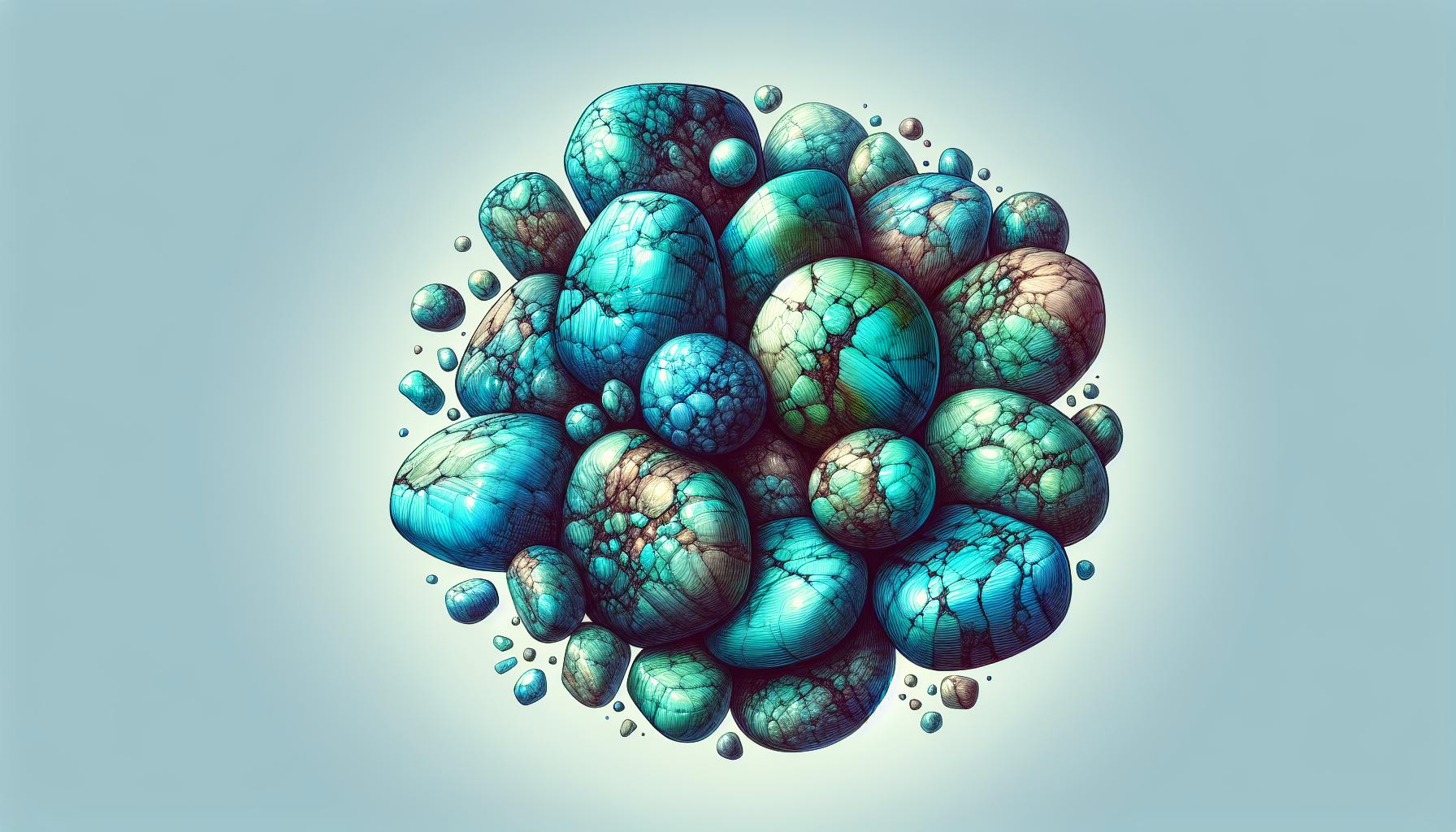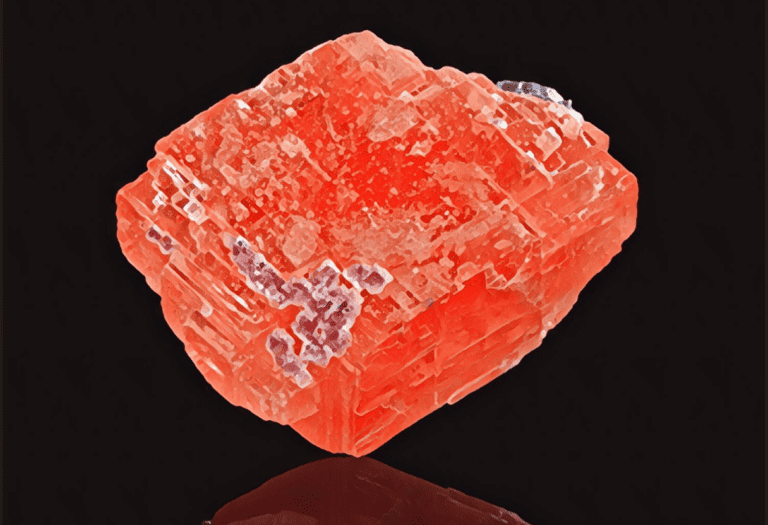Discovering the allure of raw turquoise can be as thrilling as finding a hidden treasure.
But before you claim your prize, it’s crucial to ensure it’s the real deal. You’re not alone in your quest; many enthusiasts and collectors are on the lookout for genuine turquoise.
Knowing how to identify authentic raw turquoise is essential in a market flooded with imitations. From its distinct color and texture to the specific gravity that sets it apart, there are telltale signs that can guide you.
Let’s delve into the art of distinguishing true turquoise from the fakes.
Identifying raw turquoise involves checking for blue to greenish-blue colors, veined patterns, and waxy luster. It’s not magnetic, leaves a greenish-bluish streak on porcelain, and has a Mohs hardness of 5 to 6. Turquoise is typically opaque with a specific gravity of 2.6 to 2.9.
Raw Turquoise vs Turquoise
Raw turquoise and turquoise, while closely related, are distinct in terms of their appearance, composition, and uses. Raw turquoise refers to turquoise in its natural, unaltered state, as it is found in the earth. It typically appears as rough, uncut stones with a variety of colors, ranging from greenish-blue to sky blue, and may contain veins or matrix, which are other minerals or rocks intertwined with the turquoise.
On the other hand, turquoise refers to the same mineral but after it has been processed and shaped into various forms, such as beads, cabochons, or carved jewelry. This processing often involves cutting, polishing, and sometimes stabilization to enhance its durability and appearance. As a result, turquoise becomes smoother, more vibrant in color, and easier to incorporate into jewelry and decorative items.
Turquoise, whether raw or processed, has been valued for its beauty and cultural significance for centuries. It is commonly used in jewelry, especially in Native American and Southwestern designs, as well as in art and sculpture. Turquoise is believed to have metaphysical properties, symbolizing protection, healing, and wisdom, making it not only a stunning gemstone but also a cherished cultural and spiritual symbol. Ultimately, the choice between raw turquoise and processed turquoise depends on personal preferences and the intended use, with both forms offering their unique allure and charm.
How to Identify Raw Turquoise Through Testing
When you’re on the quest for authentic raw turquoise, knowing how to test for genuineness is key. Here’s how you can verify your find by conducting a variety of tests.
Visual Inspection
First things first, take a good look at the stone. Genuine turquoise is typically found in hues ranging from sky blue to greenish-blue. Examine the rock for uneven coloration and a matrix of veins—these are the telltales of real turquoise. The stone should neither be too shiny nor perfectly uniform, as these can be signs of a fake.
The Streak Test
The streak test can help determine the powder color of turquoise. Rub the stone across unglazed porcelain; if it’s real, it should leave a greenish or bluish streak behind. Fakes often leave no streak or a colored streak that doesn’t match the stone.
Magnet Test
While the magnet test isn’t foolproof, it can be revealing. Genuine turquoise is not magnetic. If your specimen pulls towards a magnet, it’s likely you’re dealing with dyed magnesite or another mineral.
Hardness Test
Turquoise has a hardness of about 5 to 6 on the Mohs scale. Try scratching the surface with a knife or a pin. If it easily scratches, it might be an imitation, as true turquoise resists most casual attempts to scratch it.
Birefringence Test
Birefringence refers to a mineral’s property of splitting light into two rays. Since turquoise is usually not birefringent, if you observe this phenomenon while looking at your stone through a loupe, you may have a simulant.
Checking The Diaphaneity
Diaphaneity, or light transparency, in turquoise ranges from transparent to opaque. Typically, turquoise is opaque, so if light passes through it, question its authenticity.
Single or Double Refraction
Turquoise is generally a single-refraction gemstone. If a double refraction is found through a dichroscope, the stone is likely not a pure turquoise.
Refractive Index Test
Professional jewelers can assess the refractive index (RI) using a refractometer. For turquoise, the RI should be approximately 1.61 – 1.65. A reading outside this range indicates a possible imitation.
Finding The Specific Gravity
The specific gravity (SG) of turquoise is typically between 2.6 to 2.9. An SG significantly off this range may signal that the stone is not genuine turquoise. Precise measurements would require lab equipment.
Identifying Raw Turquoises in the Field
When determining raw turquoise in the field, look for stones in regions known for turquoise deposits. Look for veins in host rocks and examine stones for the characteristic blue-to-green color and waxy luster.
Recognizing Potential Raw Turquoise Rocks
Even with a trained eye, it takes practice to recognize raw turquoise rocks in their natural environment. Prospecting in known turquoise mines and comparing your finds with authenticated specimens can sharpen your identification skills. Keep an eye out for the unique color, veining patterns, and context clues such as the geological formation they are found in.
Physical Characteristics of Raw Turquoise

As you embark on the exciting journey of turquoise identification, it’s crucial to recognize the unique physical characteristics to look for:
- Color: Raw turquoise ranges from sky blue to green, with the most prized being an even, intense blue.
- Matrix: These are the brown or black veins running through the stone, resulting from its host rock.
- Texture: Genuine turquoise may exhibit a waxy to matt surface when unpolished.
- Shape: Stones often appear in nuggets or as encrustations on a host rock.
While assessing raw turquoise, be mindful of its hardness—typically between 5 and 6 on the Mohs scale. This indicates that the stone can scratch glass but is softer than quartz. Another telltale sign is its weight; turquoise is a lightweight mineral which makes it distinguishable from heavier imitators.
Keep an eye out for common treatments, like dying, which can enhance color but diminish authenticity. True raw turquoise may also display mottling or an uneven color distribution that adds to its uniqueness.
When examining for translucency, you’ll notice that raw turquoise is generally opaque. However, some specimens might show a slight translucency at the edges.
Employing these criteria will direct you towards making a more informed assessment of your turquoise finds. Remember, a keen eye and a little practice will significantly enhance your stone identification prowess.
How Are Raw Turquoise Formed?
Raw turquoise is a mineral that is typically found in arid regions, where it forms through a process known as hydrothermal activity. This process occurs when water percolates through rocks deep underground and dissolves certian minerals. Over time, the water evaporates and leaves behind rich deposits of these minerals—including copper, phosphorus, and aluminum—as it moves through porous rocks. It’s these elements that give turquoise its distinctive blue-green hues.
In geographical zones where copper is naturally present in the soil, turquoise formation is more common. The minerals crystallize in veins within host rocks, which are usually of volcanic origin like rhyolite or sedimentary rock such as limestone. The presence of other minerals can affect the color and quality of the turquoise; for example, iron can turn it greener, while zinc may make it more yellowish.
The formation process of turquoise is slow, taking from hundreds to thousands of years. Consequentially, this gemstone is not only a marvel of beauty but of geological processes as well. Exploring regions that have a history of turquoise mining can lead you to areas where raw turquoise formation has occurred. When you’re on the hunt for this precious stone, you may find it in the form of nodules or as a crust lining fractures in larger rocks.
By understanding how raw turquoise forms, you can better appreciate the factors that influence its quality. Additionally, this knowledge can help in identifying likely geologic settings where raw turquoise deposits might be found. Keep in mind that while turquoise is relatively abundant, factors such as vein thickness, accessibility, and the presence of other minerals greatly influence where sizable deposits may be located.
Preparation for Raw Turquoise Hunting
Gathering the Right Tools
Before you set out on your quest for raw turquoise, it’s essential to equip yourself with the appropriate gear. A geologist’s hammer and chisel are key for extracting samples from larger rock formations. You’ll also need a hand lens or jeweler’s loupe to closely inspect the rocks you find for tell-tale signs of turquoise. Bearings on where resources like water can be found are imperative in remote hunting locations. Remember, losing your way can result in wasted time and a missed opportunity to find this precious stone. Carrying a GPS device or detailed topographic map of the area could avert a crisis.
Another item you may want to add to your toolkit is a UV light. Some variations of turquoise may fluoresce under ultraviolet light, making it easier for you to spot potential finds. Also, don’t forget containers or bags to safely transport any turquoise samples you collect. And lastly, ensure you have ample note-taking materials to record the specifics of your discovery spots for future reference.
Safety Considerations
Hunting for raw turquoise involves traversing rugged terrain, so prioritize your safety above all else. Wearing sturdy boots is a non-negotiable factor as they provide the necessary grip and protect your feet. Additionally, a helmet could be a lifesaver in areas prone to rock falls. Gloves are advisable not just for warmth in high altitudes but also to protect your hands when hammering and prying samples from rocky enclosures.
Always carry a first-aid kit and ensure it’s well-stocked with treatments for cuts, sprains, and other common injuries. Hydration is also crucial, especially in arid environments typical of turquoise deposits, so pack an adequate supply of water. Being versed in the basic survival skills can make all the difference, and remember, letting someone know your plans and expected return helps in case of an emergency.
Factor in the local wildlife; carrying bear spray or other deterrents might be recommended if you’re in an area with potentially dangerous animals. Lastly, familiarize yourself with the weather patterns of the region to avoid being caught in rainfall or storms which could make your turquoise hunt not only unpleasant but also treacherous.
Handling and Care of Found Raw Turquoise

Once you’ve found raw turquoise, it’s crucial to handle and care for it properly to maintain its natural beauty and integrity. By following best practices for cleaning and storage, you’ll ensure that your turquoise stones remain as stunning as the day you found them.
Cleaning Raw Turquoises
After collecting raw turquoise, the first step is cleaning. Turquoise is relatively porous, which means you’ve got to be gentle during the cleaning process. Avoid using harsh chemicals, abrasive materials, or ultrasonic cleaners, as these can damage the stone. Here’s a basic method to clean your raw turquoise:
- Use warm water and a soft brush.
- Gently scrub the stone to remove any dirt or debris.
- Rinse the turquoise with clean water.
- Dry it with a soft, lint-free cloth.
Remember that raw turquoise might have a delicate matrix—the host rock, which often includes intricate patterns. So handle the stones with care to keep this matrix intact.
Storing Raw Turquoises
Proper storage of raw turquoise is as essential as cleaning. Keep your stones in individual containers or wrapped in a soft cloth to prevent scratching. Factors to consider for optimal storage include:
- Temperature: Store at a stable, room temperature.
- Humidity: Keep stones in a dry environment to prevent water absorption.
- Sunlight: Turquoise can fade if exposed to prolonged direct sunlight.
For collectors with a number of specimens, consider labeling the containers with details like weight, location found, and date. This helps in maintaining an organized collection and makes it easier to reference your finds in the future. If you’re using pouches or fabric, ensure they are made from materials that do not leave residue or fibers that can get embedded in the turquoise.
Taking steps to preserve your raw turquoise begins with understanding it’s a treasured stone that requires careful attention. Always handle with care, and remember that every piece of turquoise is unique—requiring individual consideration for its needs. This way, your finds will continue to captivate with their unbeatable charm and rich, storied history.
Conclusion: Confirming Real Raw Turquoise
You’ve gained the knowledge to distinguish genuine raw turquoise from imitations.
Remember, the key is in the details—color nuances, matrix patterns, and hardness. Your newfound understanding ensures you can identify the real gemstone confidently. With proper cleaning and storage, you’ll preserve the allure of your turquoise.
Embrace these practices and cherish the natural beauty of your find for years to come.







